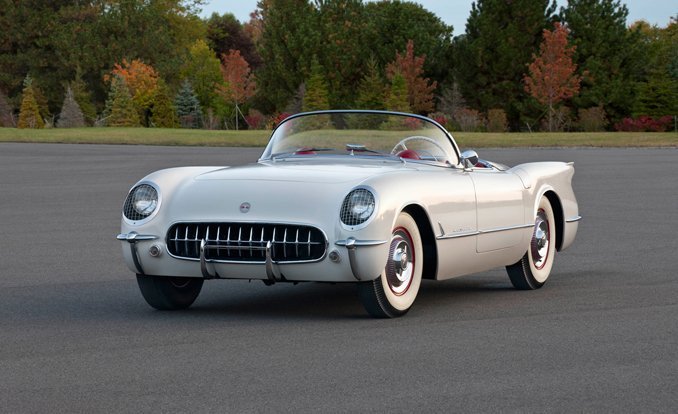|
|
The Corvette’s first year of existence, 1953, had been a challenging one. After the car’s headline-grabbing debut in New York, Chevrolet had struggled to complete 300 largely hand-built ’53 Corvettes in a temporary production facility in Flint, Michigan. By December 1953, however, a newly renovated assembly plant in St. Louis was ready. By June of 1954, the St. Louis factory was turning out 50 Corvettes a day.
Mass production and the resulting economies of scale had a welcome effect on the Corvette’s window sticker. In 1954, the base price dropped from the original car’s $3498 to $2774. Chevrolet also started advertising its new two-seater, including a print campaign with the headline: “First of the dream cars to come true.” The words weren’t hyperbole — the Corvette was gaining in recognition and availability. Indeed, by the end of the year Chevrolet had produced 3640 Corvettes — more than ten times as many as the year before. Slowly, steadily, Harley Earl’s vision was changing the face of the American sports-car scene.
This was a year for bringing life to the Corvette — in preparing for 1954, Chevrolet had focused on the production line rather than on engineering breakthroughs. As a result, changes to the ’54 model were generally minor. A mid-year camshaft modification raised the output of the Blue Flame Six by five horsepower, to 155 (the two-speed Powerglide automatic transmission remained standard). The stainless-steel exhaust tips were lengthened (on the ’53 model, the shorter exhausts had shown a tendency to stain the paint on the close-fitting bodywork). Paint choices increased to four, with Polo White being joined by black, Sportsman Red, and, toward the end of the year, Pennant Blue. Convertible tops were now tan instead of black. Door handles were redesigned for easier operation.
Such improvements were welcome, but to the public, progress on the Corvette in 1954 must have seemed measured at best. Behind the scenes, though, Chevrolet’s engineering offices were a whirlwind of activity. Feeding the storm was an ambitious new Chevy engineer whose name would soon become synonymous with the Corvette’s: Zora Arkus-Duntov. Born in Belgium to Russian parents, Duntov had grown up in Europe studying engineering and driving race cars. After joining Ed Cole’s Corvette team in 1953, he immediately began an determined crusade to forge the Corvette into the true high-performance sports car he was certain it should be. It wasn’t enough, Duntov reasoned, for the Corvette to be as visually captivating as rival models from Jaguar and MG and Ferrari. The Corvette had to deliver the performance goods, too. That meant more power, a manual transmission, and a more sophisticated, handling-tuned suspension.
Duntov found sympathetic ears at Chevrolet. In fact, his chief concern — the Corvette’s lack of world-beating horsepower — was already being addressed. Cole’s engineering team spent much of 1954 developing a new Corvette engine for the 1955 model year. And, in time, Duntov would have ample opportunity to utilize his considerable talents to create ever-better and faster Corvette models.
For now, though, the Corvette was being pushed ahead by a force even more compelling than Duntov. It was called the Ford Thunderbird. Unveiled at the 1954 Detroit Auto Show, the two-seat Thunderbird boasted a V-8 engine, both manual and automatic transmissions, roll-up windows, and a removable hard top. Longer, wider, and more luxurious than the Corvette, the T-Bird lacked the Vette’s sports-car “purity.” Still, it was a contender that Chevrolet could not afford to ignore.
So the battle was officially on. It wouldn’t last long: by the 1958 model year, under mounting pressure from the increasingly potent Corvette, Ford would drop its two-seat Thunderbird model altogether. Without benefit of a crystal ball, though, in 1954 Chevrolet knew only that it had a tough fight ahead.
For the Corvette’s development team, the coming years promised to be as demanding as they were fulfilling. For the Corvette’s growing legion of fans, the best news was just around the bend. Chevy’s fiberglass dream machine was about to shift into high gear.


Leave a Reply